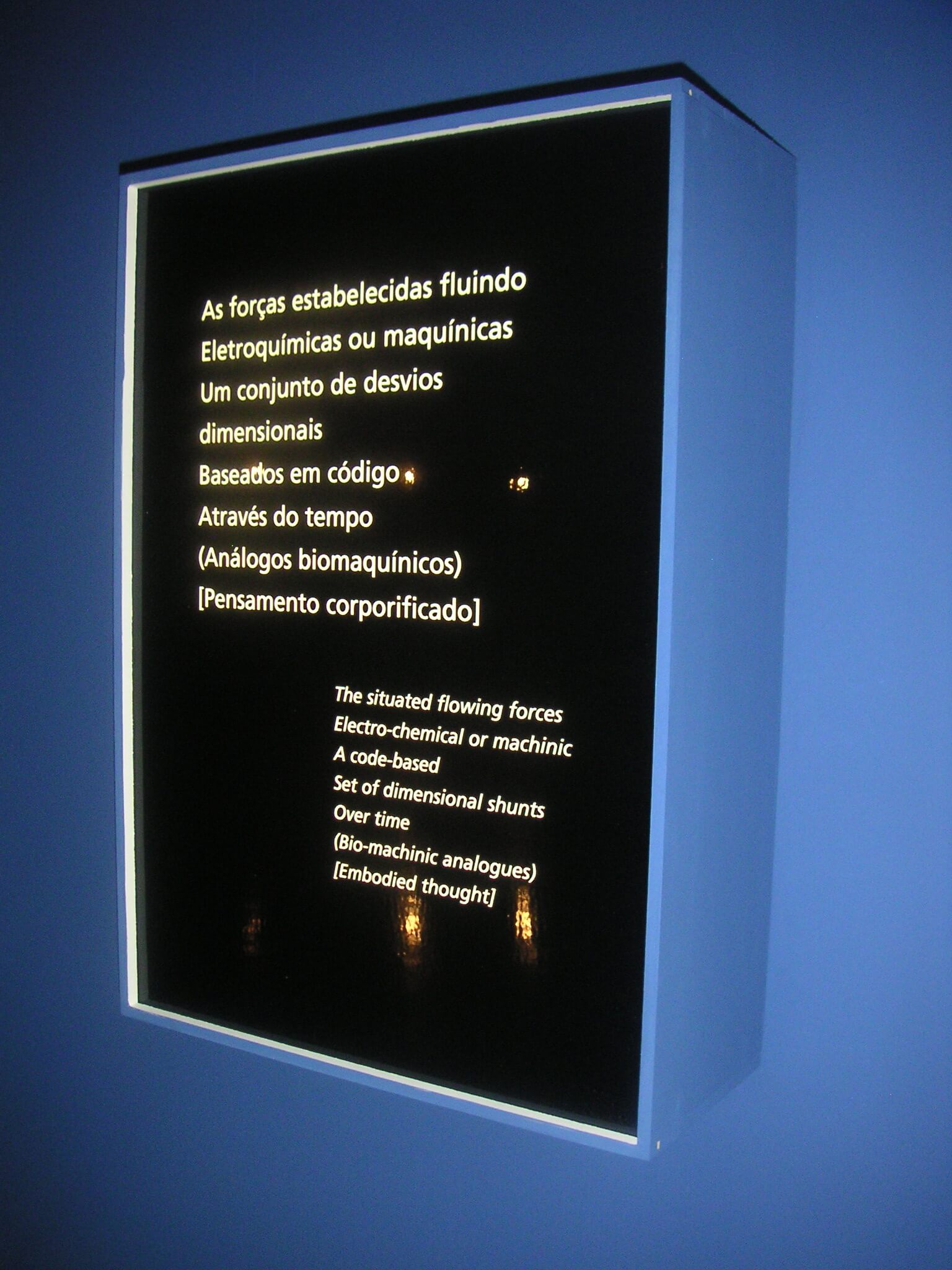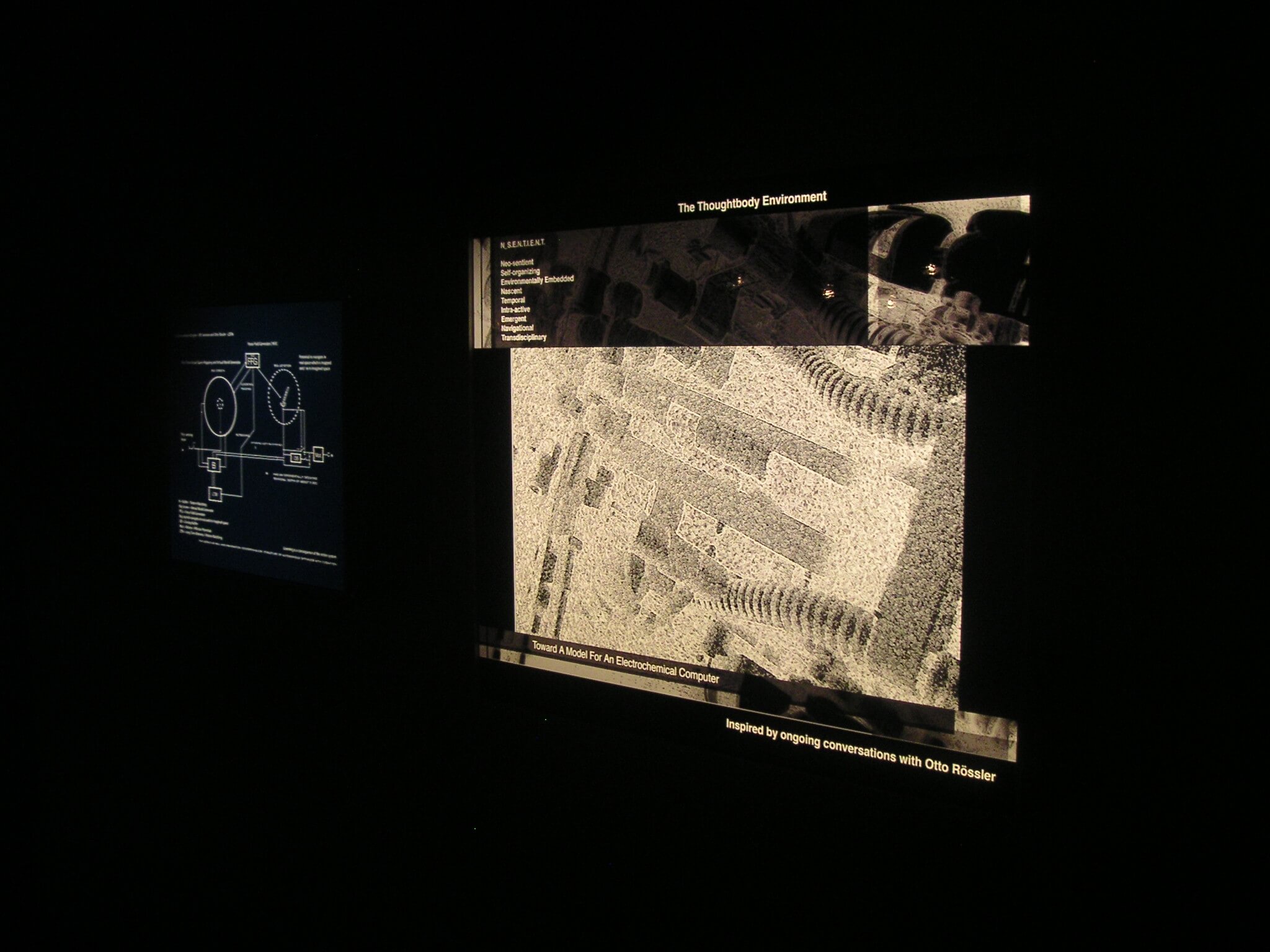





The Thoughtbody Environment
Toward the development of A model for a Situated Electro-chemical Computer
Extending a Collaboration between Otto Rössler and Bill Seaman
Interface
Download Text
In order to model and ultimately build an electro-chemical computer, one seeks to understand operative processes from the body and re-understand them in the context of a device that is not human in nature. The notion of exploring a similar operative substrate to that of the body, flowing electro-chemical activity, is central. The residency would be used to develop the broad parameters for the modeling of this dynamic “Thoughtbody” environment, exploring approaches to ongoing reception of “sense” pertubations, the parsing and/or reaction to these “perturbations” and relevant “change” or reciprocal action in the environment, drawing directly from current interdisciplinary and/or transdisciplinary scientific understanding. Collaborative interdisciplinary and transdisciplinary discussion of the nexus of problems surrounding the task will be central. Knowledge from a series of different realms will need to be brought together to articulate the breadth of driving problems.
Central to this project is interdisciplinary and transdiciplinary research. The scientific backgrounds of the researchers at the AI lab bring the necessary skills to explore such a complex problem. This project would seek to include researchers from biology, the neuro-sciences, engineering, information technology, physics, mathematics, psychology, art and design. We also see an expanded embodied linguistics as central to the project. Otto Rössler brings his knowledge from a series of differing domains.
A Synthetic ThoughtBody is a mind/body/environmental unity built up through an ongoing relation to “reciprocal forming/framing processes.” A perceived “pattern” is the ability of a set of “sensors” functioning in conjunction with the ThoughtBody to register changes that are encountered over time. The physical qualities that are “encoded “ into an electro-chemical flow become “registered” or are physically parsed. Ongoing state changes form a particular “biologically encoded” time-based multi-sensual spatial pattern or history of physical events or incidents registered both by the network of sensors and the synthetic “brain” working in tandem — the Thoughtbody. The ability to develop operational “linguistic” categories (based on these patterns) that are functionally recombinant [and thus can be applied in new contexts] is pivotal. It is central that the self-reflective “articulation process” related to environmental knowledge be build up such that it can be used to establish context in an ongoing manner — to learn from that context and operate within that context. The ThoughtBody is an environment that is embedded in a larger environment and is in an ongoing process of reciprocal action and change — mobile and/or distributed, and situated. Thus an intimate link or bridge must be established across domains and scales – functionally coupling the environmental with the embedded environment of synthetic neuronal activity.
Could it be that each time we encounter a similar set of environmental qualities [seeing a “text” also as a recombinant pattern], we draw on our “state-change residue” of related “encoded” incidents and perform a multi-modal pattern-matching, project meaning [categorical code matches] into the environmental context (also based on a build-up of a categorical set of fields) and respond in an appropriate manner based on recombining operational categorical “fragments” [define new field interconnection flows] from the history of these registered experiences, applying them to the current context? Could an electro-chemical computer be articulated such that it would basically function in the same manner?
Starting with a new premise we call “Open Order Cybernetics” (unpublished paper by Seaman and Gaugusch) we suggest that language acquisition and the production of meaning is an open, ongoing process. This is central to articulating, operating within and extending reality. This means that the electro-chemical computer will need to be situated and informed by an embodied linguistics that is built-up over an extended period of time through reciprocal action with others, “self” and environment (both informed locally and via distributed input). Embodied learning and the definition of situated-ness become pivotal.
The constructions of an extensive multi-modal sensing system is also intrinsic to the system. The registering and categorical parsing of multiple sense perturbations over time, forms what we call spatial/temporal patterns of experience. The development of a code system that can operationally parse and operate on this input is one area of investigation. Certain understandings arise in relation to specific repeated qualities of behavior and/or environmental relation (as framed through language and mutual forming relations). Our learning from pattern-perception [field intermingling] and pattern matching [field comparison] begins with our relationship to our early environmental surroundings. Certainly operational field recombinance enables the ongoing flow of thought.
We hope to gain more knowledge about mind/brain/body in the process of this research as well as to extend understanding related to each of the disciplines described above. The approach is to build a transdisciplinary vocabulary to help bridge the fields as well as to enable discussion surrounding the model and in turn the multi-model articulation of the model through visualization and sonification and other yet to be determined forms. The clear articulation and the development of a model may potentially impact approaches to research across a number of the disciplines concerned, and in particular impact contemporary approaches to AI research.